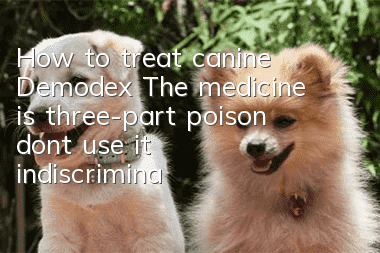How to treat canine Demodex? The medicine is three-part poison, don’t use it indiscriminately!

CanineWhat is Demodex
Demodex is a type of permanent parasitic mite that lives in the hair follicles and sebaceous glands of humans and mammals. There are 140 known species. Remaining species and subspecies. Canine demodicosis is caused by the Demodex mite parasitizing the hair follicles and sebaceous glands of dogs' ears, eyes, lips, legs, etc. Due to low immune function, systemic infection often leads to severe pyoderma. A common treatment for generalized Demodex in dogs is oral ivermectin. With antibiotics to fight infection. The skin is cleansed with iodine tincture etc. The effect is remarkable. The key to this disease is prevention.
Purebred dogs are more susceptible than mutts. Surveys of breeds susceptible to demodicosis around the world have found that regional differences are large. Chihuahuas, bullfighting dogs, chows, Shih Tzus, Tibetan mastiffs, ancient shepherds, etc. are susceptible to demodicosis. Demodicosis is hereditary and may be inherited autosomal recessively. The affected dogs and their related dogs should be prohibited from continuing to breed, which can reduce the incidence of the disease.
Clinical symptoms of canine Demodex
1. Scale type: Mainly occurs in and around the eyelids, corners of the mouth, forehead, nose and lower neck, and elbows Head, toes and other parts. Hair loss at the infected site, accompanied by mild flushing and silvery-white sticky dandruff. The skin appears slightly rough and cracked, or has small nodules. Later, the skin turns blue-gray-white or copper-colored, and the affected area is almost not itchy. Some remain unchanged for a long time, while others turn to a pustular form.
2. Pustular type: Most commonly occur in the neck, chest, inner thigh and other parts, and later spread throughout the body. There is large areas of hair loss on the body surface, large areas of erythema, and the skin is thick and often forms wrinkles. There are diffuse pustular rashes as big as millet to wheat grains. The pustules are blue-red in color and discharge pus when squeezed. They contain a large number of Demodex mites and insect eggs. After the pustules rupture, they form ulcers, knots, and unpleasant smell. stench. The pustular type also has almost no itching. If there is severe itching, it may be a mixed infection. Eventually death occurs from exhaustion, poisoning, or sepsis.
How to treat canine Demodex
Isolate and treat sick dogs, and use acaricides to disinfect contaminated places and utensils. The following drugs are used for treatment: dimethyl ether, the application concentration is 250ppm, and the body surface is bathed. Ivermectin 200 micrograms/kg body weight, subcutaneous injection. Ivermectin is a broad-spectrum anthelmintic that kills nematodes and spider insects. Therefore, it should be used with caution on dogs suspected of suffering from heartworm disease to avoid killing the heart. Heartworms, causing blockage and accidents. 14% iodine tincture, apply to the affected area. In addition to local application of insecticides to severely ill dogs, antibacterial drugs should also be applied systemically to prevent secondary infections.
- Is it better for Dogo dogs to have their ears erect or cropped? A case of Dogo dog’s ear erection surgery will tell you
- What do dogs eat to protect their stomach? It is important to protect their stomach and treat gastrointestinal diseases in dogs.
- How to tell if your dog is fat? Is your dog overweight?
- Will your dog catch a cold if you blow the air conditioner? What should you do if your dog catches a cold if you blow the air conditioner?
- What should you pay attention to when your dog drinks water? Don’t be careless when it comes to your dog’s drinking water.
- The dog's mouth bites and shakes. Why does the dog's mouth occasionally shake and bite?
- How to cut a dog's hair? Do you know how to cut a dog's hair correctly?
- Can dogs eat raw eggs? Why can’t dogs eat egg whites?
- Common Dog Problems in Summer How to Deal with Different Dog Problems
- How to keep dogs away from skin diseases. If you do this, will you see if your dog will still be infected with skin diseases?



